Nails: All dogs have them. In fact some dog breeds, like the Great Pyrenees, have 22 of them. Yet nails are commonly ignored by many dog owners. There are numerous common problems with this area in dogs, ranging from minor broken nails to more devastating diseases like cancer. Proper maintenance with nail trims and periodic inspection of the nail and nail fold will ensure early detection of any problems with your canine friend.
A dog’s nail consists of a keratinized hard outer shell, which we think of as the claw. However, inside this tough shell lies the important structure called the quick, or living part of the nail. A blood vessel, nerve, and bone are present within the claw in the area closest to the digit. The skin folds over the nail and attaches at its base forming a structure called the nail fold. Knowing normal anatomy of your pet’s nail will allow for successful nail trims and identification of problems that may arise.
Detect and Prevent Problems Through Regular Nail Trimming
Proper nail trimming can prevent most, but not all, injuries to the nails. Start counter-conditioning exercises at a young age to make pedicures for your pet much easier and more manageable.
See “A Counter-Conditioning Protocol for Trimming Your Dog’s Nails” for information on how to condition your dog to accept nail clipping, and to learn proper nail-trimming techniques.
Common Ways Dogs Injure Their Nails
Trauma is most common nail problem that we see in clinical practice, often involving fracture or complete avulsion (ripping out) of the nail from the nail bed. If trauma affects the vascular portion of the nail, pain and hemorrhage will be present.
The most frequently fractured nail is the dewclaw. The dewclaw resides on the medial (toward the middle) aspect of the limb, about halfway to the wrist, or carpus. The dewclaw is present on the forelimbs of dogs and occasionally on the hindlimbs as well. Some breed standards call for the surgical removal of the dewclaws at severals days of age to prevent this very problem.
Since the dewclaws of our canine friends typically do not make contact with the ground when exercising, they do not wear naturally like the other nails. The claws become sharp and hook-like and are easily snagged. Maintenance nail-trimming is imperative for dogs who have dewclaws to prevent them from growing too long and predisposing them to injury.
In the case that your dog does injure a nail, it is best to see your veterinarian for assessment and treatment to prevent a secondary infection. Possible treatments involve controlling hemorrhage, removing the fractured portion of the nail, and aseptically cleaning the traumatized tissue. Antibiotics and bandages are often warranted.
Owners are often timid about trimming their pet’s nails at home. However, with time, treats, and patience you can teach your pet to tolerate pedicures. In case of an accidental clipping of the quick (vascular part of the nail), have styptic powder on hand to apply to the bleeding vessel. For a more natural approach, you can use the Chinese herb Yunnan Baiyao applied topically.
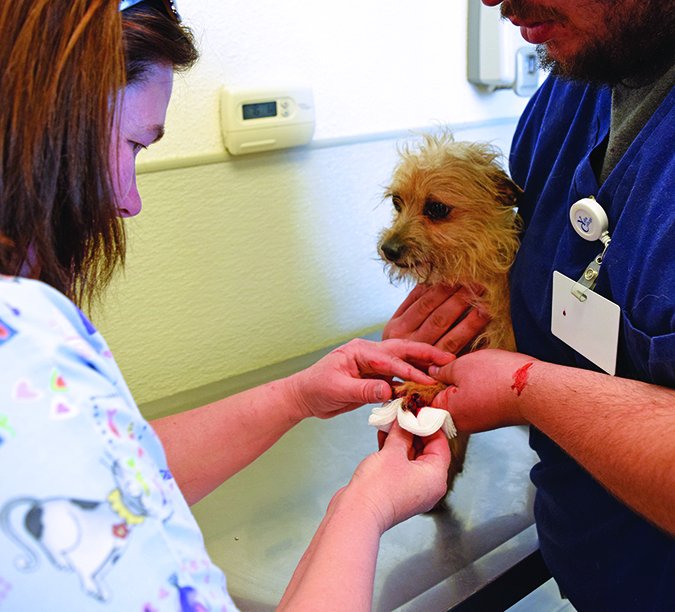
Disorders of the Nail Fold in Dogs
Primary diseases of the nail fold are those that occur spontaneously without another underlying condition. Secondary diseases arise as a result of another disease process – allergies, for example. There are numerous diseases, many of them that look very similar, that affect this particular area. We’ll discuss the most common diseases of the nail bed, including infection, autoimmune disease, and cancer.
Inflammation or infection of the soft tissues surrounding the nail is called paronychia (pronounced pair-un-NICK-ee-uh).
Since the nails are, in fact, a direct continuation of the skin, it should be no surprise that diseases affecting the skin also affect the nails. Infections in this area are typically secondary to another underlying disease, but can also been seen in immunocompromised patients.
Paronychia in dogs is most commonly caused by hypersensitivity reactions, more commonly known as allergies. Food allergies (food-allergy dermatitis) and environmental allergies (atopic dermatitis) predispose the skin to secondary bacterial and fungal (yeast) infections.
However, other endocrine or hormonal problems like hypothyroidism, Cushing’s disease, diabetes mellitus, Addison’s disease, and hepatocutaneous syndrome can also make your pet prone to secondary infections. A parasitic disease like demodicosis (mange) is more common in young or immunocompromised pets and can appear similar to other causes of paronychia.
Infections can be difficult to monitor as the symptoms can be vague and insidious in onset. Signs that your pet may have a nail or nailbed infection could include redness, swelling, or discharge from the skin surrounding the nail, or discoloration or deformation of the claw itself. Your dog may also lick her paw or exhibit signs of pain or lameness on the affected paw or paws. If you are concerned about paronychia, a trip to the vet is warranted. Early detection and treatment will speed recovery.
Your veterinarian will perform a full physical exam to determine the underlying cause of infection. These disease processes can be difficult to differentiate from one another without diagnostic tests.
Your veterinarian will likely recommend skin scrapings for cytologic analysis to help differentiate between the possible causes of the lesions. Cytology involves looking at the cells under a microscope to identifying microorganism like bacteria and yeast as well as parasites. It is also possible that she may identify other abnormal cells that are suggestive of more severe systemic disease processes, such as autoimmune disease or cancer.
If the skin or nail problems do not resolve with first-line therapeutics, your veterinarian may recommend more advanced diagnostics like bacterial or fungal cultures, skin biopsy, or even x-rays.
If an infection is diagnosed, treatment will be targeted at the claw or nail bed as well as any systemic disorder that may be the primary cause of this secondary infection. Treatment of the secondary infection may involve topical antibiotics or antifungal spray, cream, or shampoo.
In severe or chronic cases, long courses of oral antimicrobials may be warranted. Foot soaks are often beneficial. For parasitic infections, anti-parasiticides will be indicated.
Treatment of nail fold disease can be frustrating for both the veterinarian and the pet owner due to the chronic and recurrent nature of disease. This is especially true if the underlying disorder can’t be identified or is difficult to control.
Home remedies for paronychia:
– High quality diet. Optimal nutrition will support a healthy immune system.
– Discuss a proper food trial with your veterinarian if food allergies are suspected.
– Povidone iodine foot soaks. Dilute iodine with water to the color of iced tea and soak for 5-10 minutes daily. Note that iodine may stain light-colored coats.
– Epsom salt foot soaks. Dissolve ½ cup of salt per gallon of warm water. Soak paws for 5-10 minutes daily. Note: Do not use on pets with open sores.
– Omega 3 fatty acid supplements.
– Species-specific probiotics.
– Chineses herbs prescribed by your integrative veterinarian.
– Acupuncture.
An alternative or complementary approach may include dilute povidone iodine solutions, Epsom salt soaks, nutraceuticals including anti-inflammatory dose of omega 3 fatty acids, and probiotics. Your holistic veterinarian may discuss nutrition and possible herbal remedies as adjunctive treatments to a more conventional approach.
Elizabethan collars, socks, or booties are often necessary in the early stages of treatment to prevent patient from self-trauma.
Automimmune diseases manifested in the nail bed.
Infections, however, are not the only cause for inflammation of the nail bed. Other more serious problems can cause similar clinical findings. Autoimmune diseases occur when the body mistakenly recognizes its own body as a foreign invader and attacks healthy cells.
Several autoimmune diseases may affect a dog’s nail beds. Lupus or pemphigus foliaceus are among the more prevalent autoimmune diseases. Symptoms of these diseases include crusting, ulceration, and swelling of the tissue around the claw.
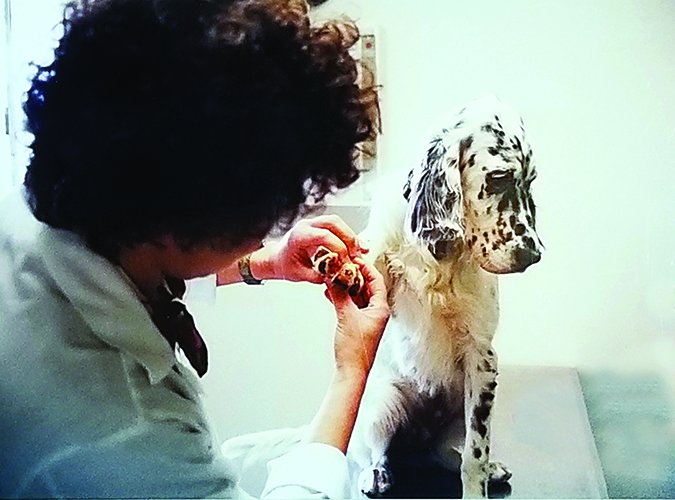
Typically, with autoimmune disease, more than one digit is affected. Diagnosis of autoimmune disease is made with a biopsy of the tissue. Treatment involves immunosuppressive medication and antimicrobials to control the secondary infections associated with the disease.
Cancer is also a concern when swelling and inflammation is present around the digit.
When cancer affects the toe, the area around the nail base is often swollen, red, and painful to touch. Cancer usually affects a single digit. Occasionally, a patient will present after the loss of a nail with no known trauma.
Like most cancers, cancer of the digit typically is found in the geriatric population. Squamous cell carcinoma and malignant melanoma are the most common cancers of the digit with certain breeds being predisposed. Darkly pigmented, large- to giant-breed dogs including Giant Schnauzers, Rottweilers, Standard Poodles, and Labradors are among the more commonly affected dog breeds. Definitive diagnosis can be difficult.
If a tumor is suspected, your veterinarian will likely recommend radiographs and possibly a biopsy of the tissue. Occasionally, even after performing the first-line diagnostics, it can be challenging to differentiate between severe infection and cancer. Amputation of the digit may be recommended both for diagnostic and treatment purposes.
Amputation of a cancerous digit can be curative. However, if the cancer is aggressive or has spread elsewhere, further treatment options are available including chemotherapy, radiation, and immunotherapy. Your integrative practitioners can help assist you with the addition of holistic modalities to support your beloved pet.
Don’t Ignore Your Dog’s Toes!
Although often overlooked, nails are important structure for dogs. With proper care and periodic home evaluation, owners can note signs of disease early. Early detection of disease will allow the owner to address the problem efficiently with the help of his or her veterinarian.
Lauren Brower Wacholder is an integrative veterinarian at Canyon Animal Hospital in Laguna Beach, California. She practices both conventional and integrative medicine including acupuncture, herbal medicine and cold laser therapy.


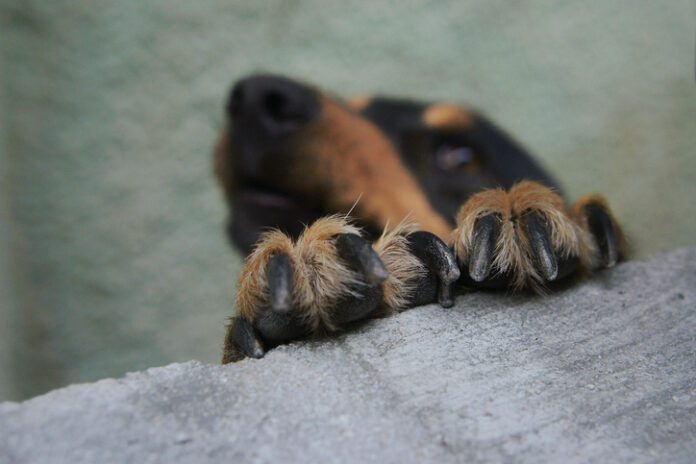
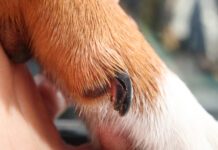

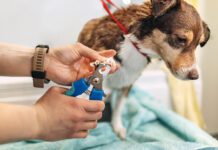
WE adopted a Walker treeing coon hound a couple of years ago when she was about 6 months old. She has a habit of chewing her toenails. She is obsessed with it. We keep her nails clipped but shes not happy until she has them pointed again. Is this normal behavior for a walker treeing coon hound?
Diana pawPrints has developed severe fear of the vet primarily because of what I consider a botched treatment for a split dewclaw. First, she was taken away from me to the back. They did not anesthetize the area enough so that when they clipped the nail I heard her scream. Ever since she has been extremely adverse to any medical procedure. And I had conditioned her to love the vet and let me touch her feet, tail, mouth etc. since she was a puppy. After that one encounter all of my hard work was forever ruined. We have since changed to a fear-free vet and she is getting a little better but still must be sedated for many routine procedures. She will not tolerate any nail trimming of even to touch her feet. I am working on desensitizing her to my holding her feet and touching her nails but it is a very slow process. I don’t know if I am ever going to be able to really trim her nails. She is quite the digger which keeps most of them trim but not the dewclaws. I really don’t have a solution except to bring my dremel and hope to trim a nail or two when she is sedated at the vet. The last time the vet got one nail done and then she came out of the sedation almost immediately.